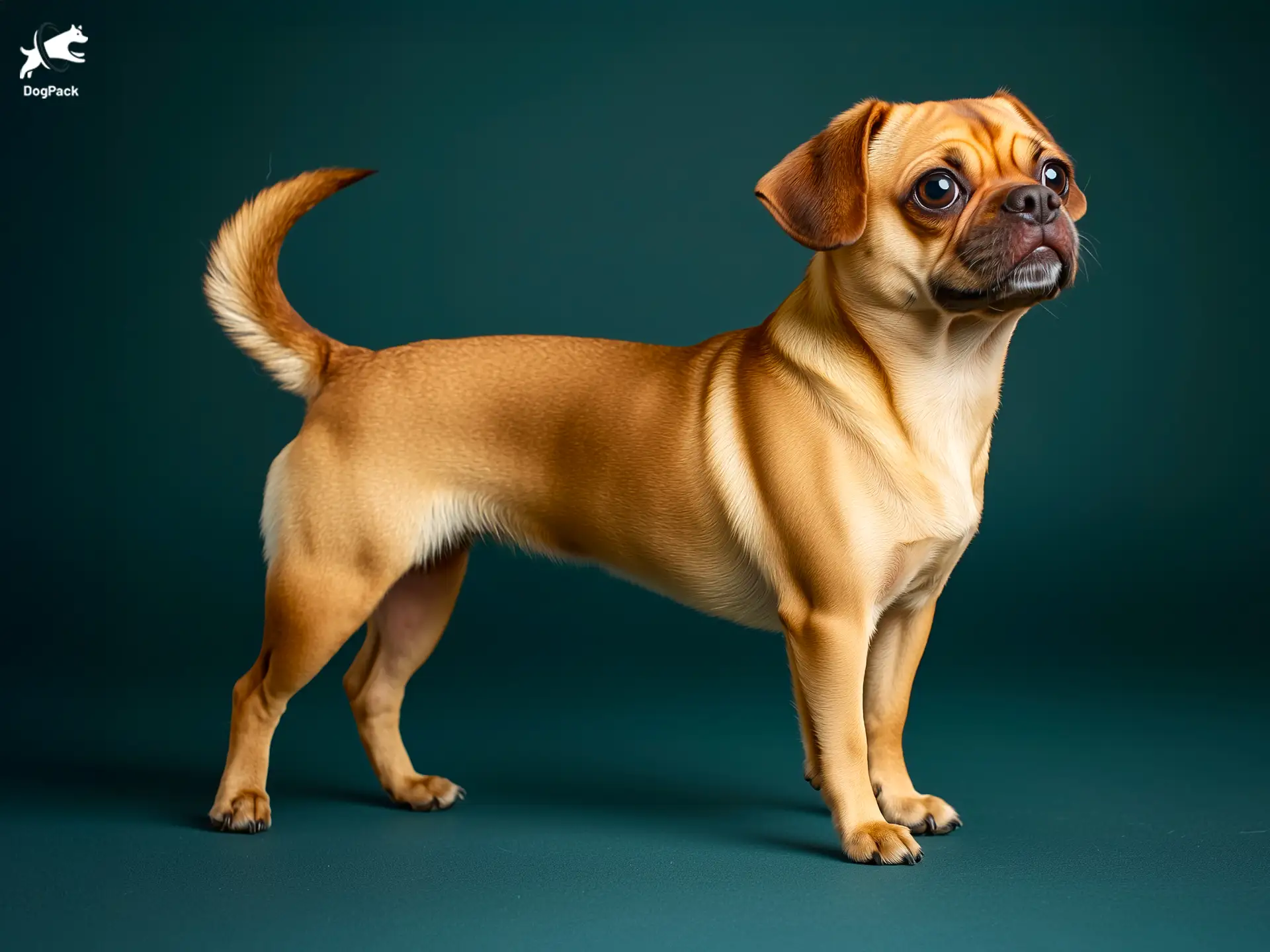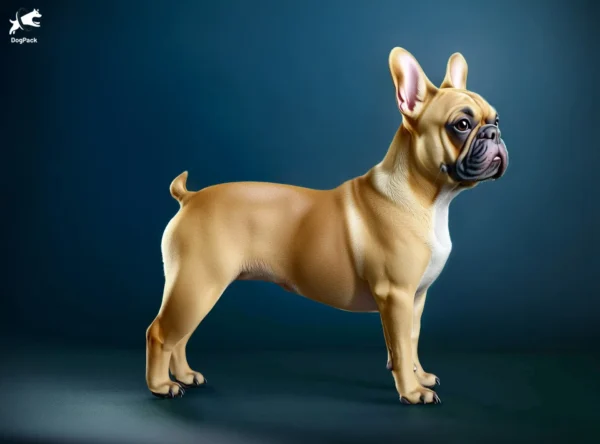Puggle Dog Breed Info & Overview
Puggles bring together the comical charm of the Pug and the curious energy of the Beagle, resulting in a friendly companion that’s perfect for many households. These dogs typically stand on the smaller side and fit well into apartments or cozy homes. Despite their modest size, they have lively personalities that keep everyone entertained and on their toes.
Characteristics
Pictures
Breed History
The Puggle’s journey began in the United States during the 1980s, when breeders started crossing Pugs with Beagles to create a fun-loving, family-oriented companion. Enthusiasts quickly fell for the hybrid’s expressive face, which combined the Pug’s wrinkles with the Beagle’s soulful eyes. This designer dog gained traction thanks to its sweet disposition and charming looks—two traits that endeared it to dog lovers everywhere.
Although the first Puggle litters appeared years ago, the breed really soared in popularity in the early 2000s. Media coverage and celebrity owners boosted its status, shining a spotlight on this playful cross. Breeders refined the lines by emphasizing health, temperament, and consistent features. This new type of “designer dog” tapped into the ongoing trend of combining two beloved purebreds to capture the best of both worlds.
Many credit the breed’s modern development to a desire for a companion that boasts the Beagle’s keen sense of smell and curiosity, blended with the Pug’s cuddly charm. Despite not being recognized as a purebred by major kennel clubs, the hybrid has a devoted following. With continuing interest and responsible breeding, the Puggle now stands as one of the more enduring designer dogs on the scene.
Temperament, Personality
Expect a lively bundle of energy when a Puggle greets you at the door. They inherit the Beagle’s curiosity and the Pug’s affectionate nature, making them exceptionally friendly toward people. Their playful spirit keeps households laughing, but they can also settle in for a cozy nap at your feet when the excitement winds down. This balance of energy and relaxation is a big part of their charm.
Around children, these dogs tend to be gentle yet enthusiastic playmates, though they thrive on supervision to ensure positive interactions. Their innate sociability often extends to other pets, especially if introduced early. Because of their inquisitive streak, they will sniff and investigate every corner of your home—and sometimes rummage through the trash if you’re not vigilant. A little humor and patience go a long way with these curious canines.
Strangers usually become friends pretty quickly, as these pups love getting attention from newcomers. That said, a cautious approach to socializing them early helps curb any shyness or watchdog tendencies inherited from the Beagle lineage. A well-socialized Puggle often strolls up to new faces with a wagging tail and a shining smile, ready to score extra cuddles and treats whenever possible.
Physical Characteristics
This cross stands out with a sturdy yet compact build. While body shapes can vary slightly, most exhibit the Pug’s rounded head and slight wrinkles across the forehead. Their ears tend to follow the Beagle’s longer, floppy style. Expect an adorable blend of facial features that draws admiration wherever they go, complete with a short muzzle—though slightly longer than a purebred Pug’s.
Coat colors range widely, including fawn, black, tan, and sometimes tricolor patterns. The coat itself is usually short and smooth, making regular brushing a quick task. These dogs have expressive eyes that light up whenever you offer treats, and their tails often curl upward, showcasing their Pug ancestry. Standing no taller than 15 inches, they’re a perfect size for urban living and smaller homes.
While overall size leans toward small or small-medium, musculature can vary based on genetics and diet. Some look more Beagle-like in their torso, while others have a chunkier build reminiscent of a Pug. Whether you spot a longer nose or a more wrinkled face, each variation highlights the unique charm of this fun-loving mix. Regardless of the exact shape, these pups exude an irresistible cuteness.
Health Issues
Like most crossbreeds, the Puggle may inherit certain health conditions from either parent breed. Respiratory issues can arise if they have a very short muzzle, but many benefit from a more moderate snout. Hip dysplasia and patellar luxation also occur in some lines, so reputable breeders prioritize screening. Regular veterinary checkups help catch potential problems before they become severe.
Ear infections can be a concern, particularly when the ears are floppy and prone to trapping moisture. Cleaning the ears carefully and ensuring they dry out after baths can help. Skin folds around the face might require gentle attention to prevent irritation or infection. While these dogs don’t usually experience severe health complications, it’s crucial to be mindful of inherited genetic predispositions.
Like any dog, a balanced lifestyle is key to preventing obesity, which can exacerbate breathing and joint issues. Because they’re partial to snacks, watch those treat portions. Setting up a consistent exercise routine, along with routine vet visits, keeps them on track for a healthier, happier life. Staying proactive goes a long way in giving your dog the best chance at a long, tail-wagging existence.
Grooming Needs
Puggles typically have a short, smooth coat that’s relatively low-maintenance, though moderate shedding does occur. A quick brush-down once or twice a week helps remove loose hair and keep the coat shiny. Regular grooming sessions are also a great opportunity to bond—just be prepared for a few playful wiggles when they decide grooming time is also playtime.
Check their facial wrinkles (if present) to ensure they remain clean and dry. A simple wipe with a gentle cleanser can prevent irritation. Because they have floppy ears, a weekly inspection and wipe-down are recommended. Nail trims every few weeks keep their paws in top shape, especially since these pups love to trot around sniffing out the next adventure.
Baths are usually necessary only once every month or two unless they get especially dirty. Over-bathing can strip natural oils, leading to dry skin. Some owners enjoy adding a bit of pampering—like a light massage or brushing after a bath—to reinforce positive feelings about grooming. By keeping sessions calm and reassuring, you’ll encourage good hygiene habits while strengthening your bond.
Exercise Requirements
A Puggle’s energy often surprises new owners, especially those expecting a lap-dog level of activity. Daily walks or play sessions help channel that spirit constructively. If you have a secure backyard, a good sniff-fest can keep them content for a while, given their Beagle side’s love for trailing scents. Just watch out: they might follow their nose into mischief if left unattended!
Aim for at least 30 minutes of brisk walking or active play per day. Many enjoy interactive games like fetch or puzzle toys that appeal to their inquisitive nature. A casual jog can also satisfy their exercise needs if your pup’s build and health permit. Because Pugs sometimes struggle with overheating, be mindful of weather conditions and provide water breaks when you’re out exploring.
If you live in an apartment, short indoor play sessions plus a couple of walks can do the trick. Consider mental stimulation as well: nose-work games or agility-style obstacles in the living room might keep them entertained. Ultimately, a happy Puggle is one that gets to stretch its legs, engage its nose, and then settle down for a well-earned nap on your couch.
Training Tips
Patience and persistence are the magic words when teaching these pups. Because of their Beagle roots, they can become fixated on interesting scents, so keep training sessions positive, upbeat, and full of treats. Praising good behavior and redirecting them gently from distractions is more effective than harsh corrections. This crossbreed thrives under consistency and structure, so start obedience lessons as early as you can.
Food rewards work wonders, but watch for overfeeding. Consider small, healthy treats like bits of lean meat or dog-safe veggies to keep their weight in check. A Puggle’s affectionate disposition means they often aim to please, but a streak of stubbornness can emerge if they sense inconsistency. Maintain a clear set of rules and stick to them, ensuring everyone in the family follows the same plan.
Socialization is crucial. Introduce your pup to varied sights, sounds, and people in a controlled manner, and they’ll grow into a well-rounded companion. Early exposure to other pets will also help curb any territorial habits. For advanced training, incorporate puzzle games that challenge the mind, capitalizing on both the Beagle’s intelligence and the Pug’s desire for human interaction. With patience, you’ll have a devoted, well-behaved friend.
Nutrition, Diet
When crafting a meal plan for a Puggle, remember that their smaller size typically requires around ¾ to 1½ cups of high-quality kibble per day, split into two meals. Because of the Beagle’s appetite, some Puggles might beg for more, but sticking to portion guidelines helps prevent weight gain. Look for formulas that balance proteins, healthy fats, and moderate carbohydrates, ensuring steady energy.
A moderate-fat diet suits these dogs well, given their blend of playful activity and potential for lazing around. If you notice your pup leaning toward the heavier side, opt for lower-calorie kibble or supplement meals with fibrous veggies. Avoid excessive fillers or artificial ingredients by selecting quality brands that offer nutrient-dense options. Regular weight checks guide adjustments to keep them trim and spry.
Some owners alternate dry kibble with fresh meats or vet-approved home-cooked meals to diversify the menu. This can satisfy picky eaters—though most Puggles are anything but picky! Ensure any add-ins don’t upset the balance of their diet. Work closely with your veterinarian to tailor a feeding plan that meets your dog’s unique needs, and keep an eye on snack intake to maintain overall health.
Adoption, Breeders
If you’re looking to adopt this mix, start by checking local shelters or rescue groups specializing in Pug or Beagle mixes, as many wonderful dogs end up there. Puggle Lovers sometimes lists Puggles in need of forever homes. Adopting an older dog can be a fantastic option, as you’ll have a clearer idea of personality and any existing health considerations.
For those who prefer purchasing a puppy, be sure to seek out a reputable breeder who provides health clearances for both parent breeds. Responsible breeders focus on healthy lines and socialized pups, allowing you to meet the mother dog and sometimes the father. Greenfield Puppies is one resource where prospective owners can browse available litters, though thorough research is always advisable.
Avoid puppy mills and backyard breeders by asking for references and visiting the breeding environment if possible. Check that puppies receive proper veterinary care and early socialization. Good breeders should be eager to answer questions about the breed’s traits, health concerns, and daily care. Whether you adopt or buy, a conscientious approach ensures you’re giving a deserving Puggle a loving, responsible home.
Family Pet?
If your household includes kids, this crossbreed can become an energetic and patient playmate. Their cheerful attitude often makes them eager participants in backyard games. Because they’re on the small side, they won’t accidentally knock over little ones as easily as larger breeds might. Teaching children how to respectfully interact with dogs fosters a positive relationship and a safe, harmonious home environment.
Some families find that these pups blend in seamlessly with other pets, including cats, as long as introductions happen slowly. Early socialization sets the tone for peaceful coexistence. Supervision is wise initially, particularly if your cat is skittish or if your pup is enthusiastic about chasing small, moving objects. With patience, a multianimal household can become a lively but loving scene.
Even though they’re affectionate, a Puggle can occasionally be vocal when excited or seeking attention. Ensuring they receive enough mental and physical stimulation limits bouts of boredom barking. Over time, families often find that a well-exercised, well-trained companion becomes a loyal, cuddle-loving friend who’s content to nap after a whirlwind play session with the kids.
Right For You?
Busy families, active singles, and apartment dwellers may all find joy in this spirited mix. Their social disposition often thrives on human interaction, so a household where someone’s around a good portion of the day suits them best. If you enjoy short bursts of activity and plenty of cuddle time, this breed’s balance might be perfect for you.
However, be prepared for possible stubbornness, especially during training. A consistent schedule and positive reinforcement go a long way. They adore attention and can become vocal if left alone for extended periods. If your lifestyle demands you’re away for long hours, consider doggy day care or a trusted walker. With the right setup, these pups adapt beautifully and return endless affection.
Before bringing one home, evaluate whether you have enough time for daily walks, grooming, and play sessions. If you’re excited about a smaller dog with a big personality—and can handle a nose that might lead them astray occasionally—then a Puggle could be the perfect companion. Ultimately, matching your situation with their needs ensures you both enjoy a happy, harmonious life together.
Conclusion
The combination of wrinkly Pug charm and keen-nosed Beagle curiosity makes this hybrid a fantastic choice for those seeking a lovable, moderately active companion. These dogs thrive in homes that offer both attention and structure, ensuring they stay engaged and well-behaved. Whether snuggled up on the couch or trotting around the block, a Puggle delights with a bright spirit that brings laughter and warmth to any household.
FAQs
-
Do Puggles have the strong scent-tracking abilities of a Beagle?
A Puggle inherits a moderate scent drive from the Beagle parent, but it’s usually not as strong. Some Puggles may still follow scents persistently, so leash training is crucial to prevent wandering when they catch an interesting smell.
-
Are Puggles prone to excessive snoring like Pugs?
Yes, some Puggles snore, but it depends on their snout length. If they inherit a shorter muzzle from the Pug parent, they may have mild breathing issues and snore more frequently. If they have a longer Beagle-like nose, snoring is less likely.
-
Do Puggles howl like Beagles?
Some Puggles inherit the Beagle’s signature howl, while others are quieter like a Pug. If a Puggle has strong Beagle traits, they may howl or bay, especially when excited or left alone. Training can help manage excessive vocalization.
-
Are Puggles escape artists like Beagles?
Some Puggles inherit the Beagle’s stubborn independence, meaning they might dig under fences or squeeze through gaps if they catch an interesting scent. A secure yard, leash training, and mental stimulation help prevent escape attempts.
-
Are Puggles prone to stubbornness?
Yes, a Puggle’s personality can be a mix of the Beagle’s independence and the Pug’s affection. This can make training challenging, especially for recall. Short, positive training sessions with treats work best, as they respond well to food rewards and praise.
Breed Ratings
The Puggle is moderately intelligent but can be easily distracted by scents, requiring patience during training.
Expect goofy antics and a love for games, especially those that engage their curious Beagle side.
With moderate to high energy, they need daily exercise but also enjoy downtime.
Short coats shed moderately, so weekly brushing helps keep hair under control.
Their Beagle heritage means they may chase small creatures if not supervised.
Low-maintenance coats and simple brushing routines make them fairly easy to care for.
They aim to please but can be stubborn; consistency and treats work best.
Extended solitude can lead to barking or mischief, so plan for company or daycare.
Vocal tendencies come from both Pug and Beagle genes, especially if bored.
Not excessive, but some drool may appear, especially around mealtime.
Generally sociable with other dogs, particularly if socialized early.
Mostly healthy, with potential issues like ear infections or hip concerns.













